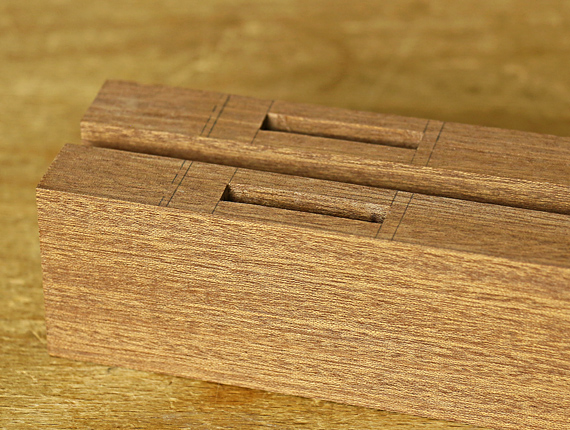
Disclaimer: Or what they do tell you but you might not notice.
Perfection is not the fundamental quality or even the goal of good joinery. Instructional promises of “perfect” joints, and especially “perfect every time,” are missing the point.
The skillful craftsperson is always is working within a sensitively understood range of tolerance. Understanding that range, and what lies beyond each end of it, are the keys to excellent work. You practice and refine your skills to develop that understanding and feel. You do not practice with an eye on perfection. The pursuit of “perfect every time” is naive and counterproductive because it misses the point.
This is generally true in any field. The mason knows the idea is to make a good wall despite the imperfections inherent in every brick. The violinist continually makes tiny variances in the intonation of notes depending on the musical circumstances. I think if you ask a pitcher what is the perfect curve ball, he would say the one that ends up in the catcher’s mitt after the batter swings.
And yet woodworking joinery seems to often be taught, and woodworking machinery promoted, as if the idea is to make, if you could, a 9000-micron tenon to fit into a 9000-micron mortise. And when you inevitably fail, you are supposed to keep practicing with that perfection as your target.
I suggest instead that you practice to learn how much deviation to tolerate from flat, straight, square, on the line, etc. Learn how fit can vary and still function and look great. This is not to license sloppy work! Your work can and should be excellent. But learn when and how variance matters. Learn tricks to make small deviations cancel through the building process. Understand the concept of one-sided tolerance. (Please see this post.)
Appreciate too, that wood is compressible and this varies with the species so you must adjust your tolerances. Consider that the ideal (I don’t mean perfect) tenon fit where you gently and evenly swoosh, not force, the tenon into the mortise, and then it stays when you hold the assembly upside down. That involves slight wood compression, and you have to work with that.
There’s another thing “they don’t tell you.” It is fine to practice making an individual joint such as a mortise and tenon but you have not mastered the joint until you can make it in context such as eight of them working together in a table. The same is true for case joints like dovetails. So, by all means, practice, but practice intelligently, and don’t forget that you have to also practice by making things.
Do not get distracted by perfection. Aim for excellence.


Agreed! Context matters so much to the tolerances you need to shoot for – the mortise/tenon fit for a short legged stool is different from those required on a matching set of cabinet doors, where they need to lay flat to the casework and each other, without anything much holding them in place.
Excellent.
3 points:
1. 1/32 is the tolerance of the finest furniture. Rarely if ever 1/64th inch. I’ll see 1/16th even with very high end stuff.
2. Look at the highest end makers work: very rough wherever things aren’t seen. And rarely very close to perfectly square
3. Agree totally when you say to make things. I have never endorsed “practicing” woodworking, as is typically taught. Don’t practice saw cuts, dovetails, etc. Honestly, I think that’s fine if you have endless free time. I endorse to just start making stuff and you’ll learn what you need, and get very good at it because so much of woodworking is incredibly repetitive.
That’s the philosophy at my furniture and carving classes: MaineCoastWorkshop.com
-Wm. Francis Brown
LineAndBerry.com
Thanks, Bill. Great to hear from you.
Readers, take a look at the incredible artistry and precision of Bill’s creations:
https://www.lineandberry.com
That will help put his comments in context. Amazing work.
Rob
I’ve never been able to get behind doing a lot of isolated practice either. If I’m trying to do something new I will do test pieces. But as noted above, free time is limited, and it’s much more compelling to just make something. And if it doesn’t come out “perfect”, well, I figure out how to fix the problems and continue. My last set of mortise and tenons for cabinet doors were a little looser than I wanted, but after drawboring, they were quite solid.
I agree, Adrian. After all, everything we make is, in a sense, practice for the next thing we make.
Rob
My wife and I built handcrafted wooden jewelry boxes for 15 years. The boxes all used mitered joints with mini biscuits. The first thing I learned was if you cut the corners at exactly 45 degrees, you were in trouble. Wood!
With something as small as a jewelry box, a 1/64th gap at the corner looked like the Grand Canyon. A gap of 5/1000 I could fill. Our life was based on thousandths.
For the first 5 years, our craftsmanship was ok, just ok. But after that, I had learned so much about our specific product that our craftsman improved enough that we could mention it in our ads. We graduated from OK to Fine Craftsmanship.
Yes, it takes work and a love affair with your product. And you can add luck into the formula also.
Thanks for the comment, Henry. What an instructive account! Again, we see that theoretical perfection is not our guiding star. Rather, we must understand and execute intelligent deviations from theoretical perfection, and learn the amount and direction of tolerance from it.
That is an important component of fine craftsmanship.
Rob